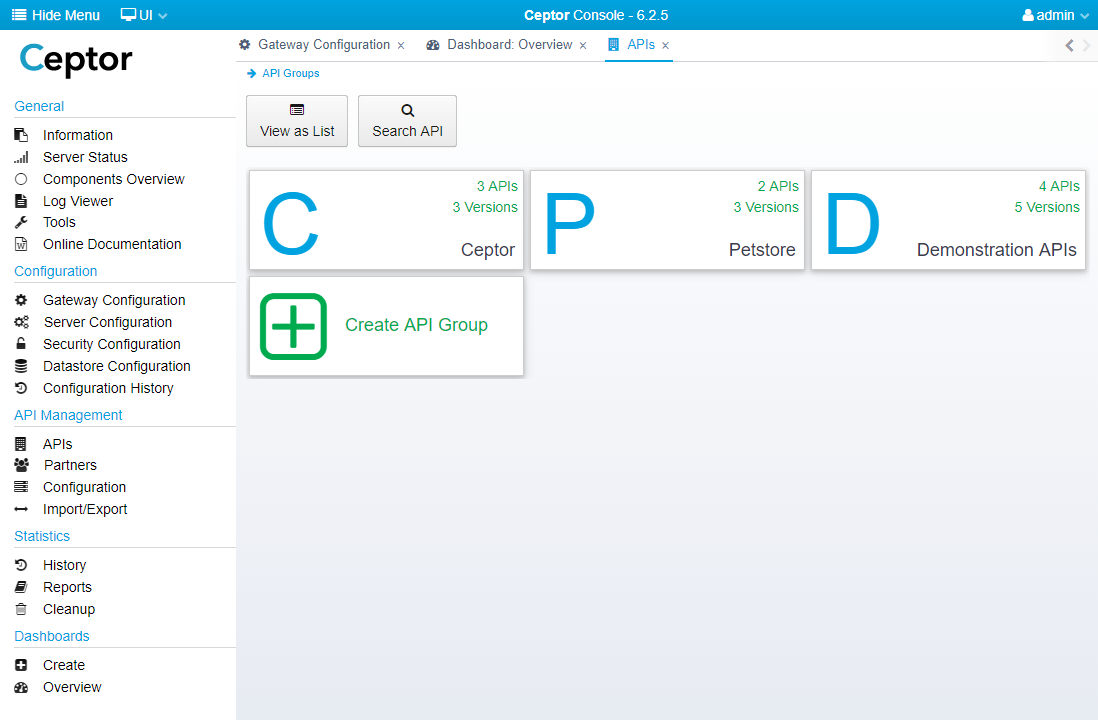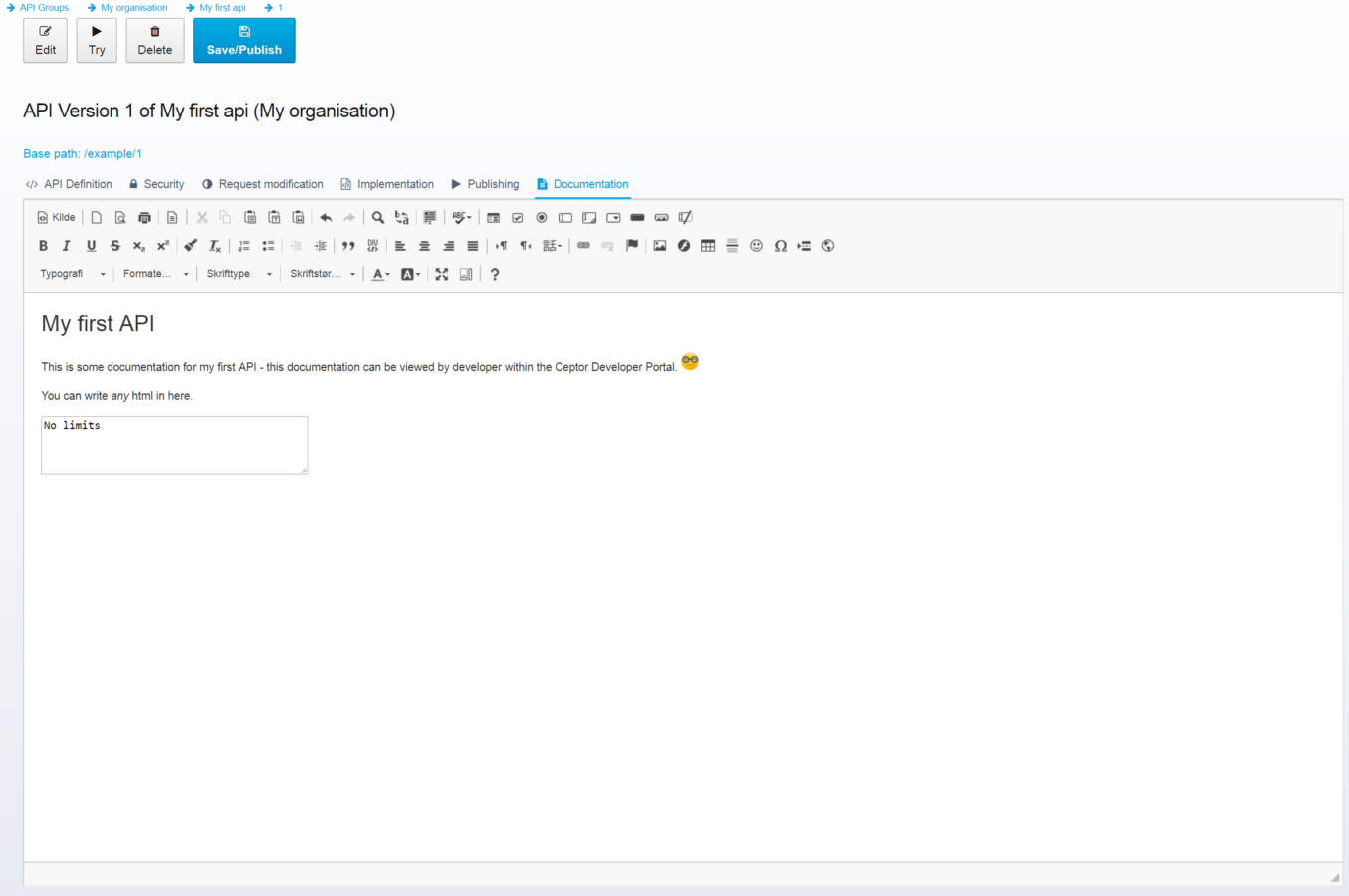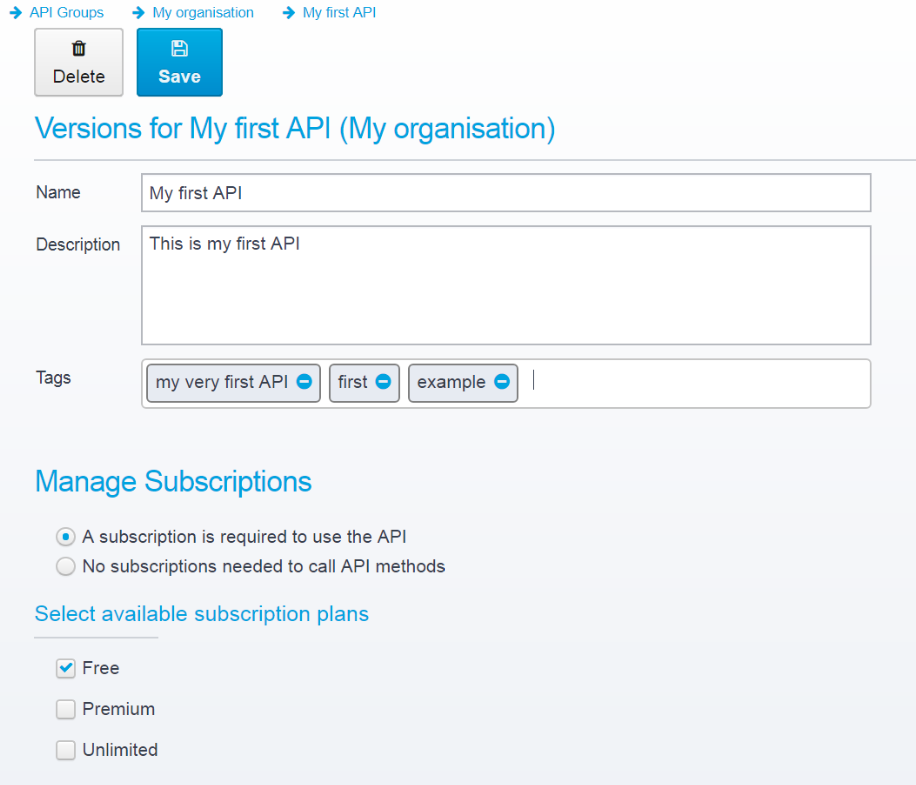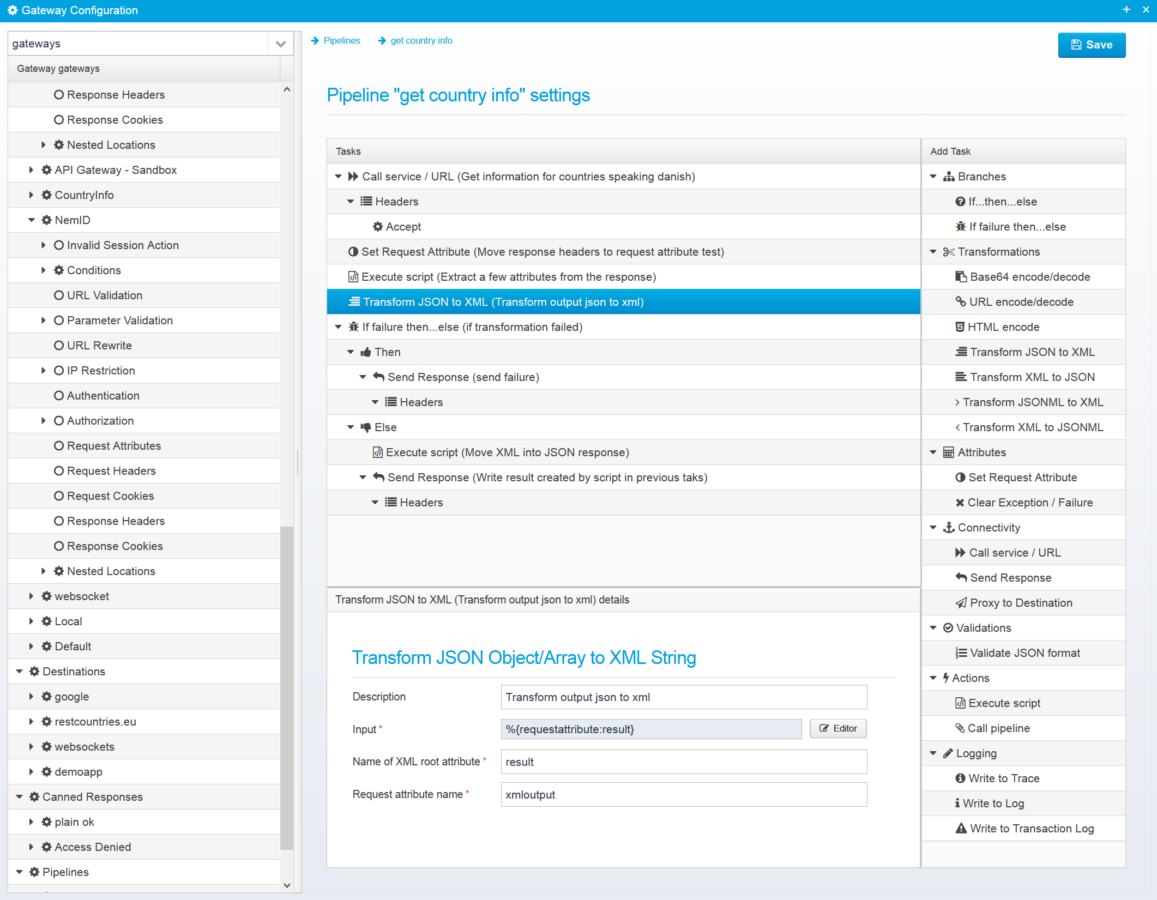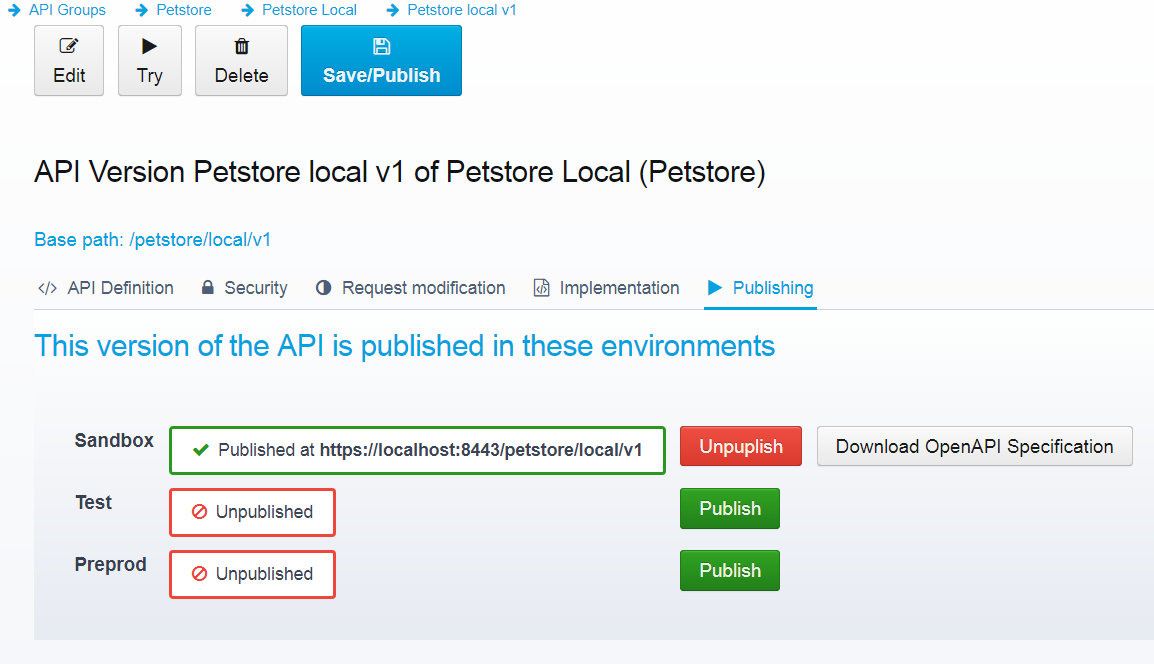Creating and Editing APIs
This page describes how to easily create, edit and publish your APIs within the Ceptor Console
Creating APIs in Ceptor Console
You can create your APIs by creating an API Group then create a new API within the group and specifying a version of your API
Documenting Your APIs
Document your APIs with OpenAPI specification or use Ceptor's built-in HTML editor
Subscriptions and Security
Choose from a rich set of options for customizing security for your APIs
Implementing APIs
You have several options for how to implement an API and its operations
Advanced Implementation Using Pipelines and Tasks
The Pipelines and Tasks functionality that allows you to drag tasks together to perform different actions
Publishing APIs
Publish your API in an environment and choose whether to restrict the subscription or security settings
Ceptor API Types
Ceptor API Management supports three different types of APIs
OpenAPI Specification
Ceptor supports both version 2 and version 3 of the OpenAPI Specification. Version 3 is highly recommended since it offers more features.
SOAP / WSDL
For SOA / SOAP / WSDL services, you can maintain your WSDL within Ceptor and expose it to your clients.
Plain HTTP
With some services that are less structured or are described in a different format - you can also define these services as plain HTTP services within Ceptor
Creating APIs in Ceptor Console
You can create your APIs by creating an API Group then create a new API within the group and specifying a version of your API
Creating API Groups
An API Group contains your APIs. You can create as many API Groups as you need. From the APIs menu, you can see the currently defined groups, and create new API Groups
When you create an API Group you can:
- Specify a name for your API Group
- Write a description
- Add any tags that can be used when searching for APIs
Creating APIs
APIs are found in API Groups. API covers one or more versions of that API that are deployed separately.
When you create an API you can:
- Decide if any subscription is required
- Add any additional tags
- Choose a name for your API
- Write a description
If subscription is required, your API Partners can subscribe to them choosing one of the defined Subscription Plans, which limits the rate they can call your APIs in.
Creating API Versions
Once you have created an API, it is time to create a specific version of it.
An API Version is a specific version of an API - e.g. "Version 1", "v1", "v1.1" or any other name you wish to assign to it
When you create an API Version you can:
- Specify a name for this version of your API
- Specify a base path
- Select the API Type,
- Write a description
You can choose to create a new API Version from a template or copy an existing one. If you choose to copy, all settings, implementations and API specification information will be copied to your new version.
Documenting Your APIs
Keep track of all your APIs using the OpenAPI specification
You should document your APIs as much as possible, so make full use of descriptions for all operations, parameters, attributes etc.
But, in some cases this is not enough and you need a higher level of documentation - or your API might not be OpenAPI Specification, but might be WSDL / SOAP or plain HTTP.
For these cases, you can write documentation for an API using Ceptor's built-in HTML editor. Simply navigate to the Documentation tab for an API version, and begin editing your HTML. You can either use the built-in editor or switch to HTML source mode and write the HTML source code directly.
Subscriptions and Security
Get a rich set of options for customizing the security for your APIs
Authentication Methods
Below are some of the most common authentication methods, many more are available.
API Key
API Key is the simplest form of authentication, your API Partner applications have one or more API keys defined for them - and any given one of them identifies that API Partner Application as the caller. Note that this API key should be treated as a secret password, which it essentially is.
Client Credentials / Basic Authentication
By enabling basic authentication, you enable your API Partner Applications to authenticate by providing their client_id and client_secret as userid/password in a Basic Authentication. Note that as usual, you should in the Ceptor Gateway ensure that all only https/encrypted connections are used.
OpenID Connect Authentication
Almost the same as OAuth 2.0 authentication, but exposes the OpenID Connection configuration metadata URL in the OpenAPI definition, The URL is usually https://www.yourorganisation.com/.well-known/openid-configuration
Bearer Authentication
This enables authentication using a bearer token, an access token earlier issued using OpenID Connect / OAuth 2.0
OAuth2 Authentication
Essentially the same as bearer authentication, but provides the OAuth 2.0 authorize and token URLs in the OpenID Configuration, and allows specifying what scopes to require.
Other forms of Authentication
You can secure your APIs anyway you want using e.g. SPNEGO / Kerberos, WS-Security, SAML or other means of authentication if you just set it up in the API Gateway.
Authorization Methods
As with any Location in Ceptor Gateway you can specify detailed authorization requirements per API or API operation
Permissions, ACLs and ABAC
Specify a required permission to get access to this location. See authorization for more information.
Permissions and ACLs can contain very advanced functionality, such as ABAC (Attribute-Based Access Control) - see authorization for more information.
Required Roles
List of roles/groups, if any roles are specified, at least one of them is required to access the resources.
Authorization Script
Custom script (JavaScript, Groovy or Python code) which can perform complex authorization decisions
Implementing APIs
You have several options for how to implement an API and its operations.
Mock APIs, or using JavaScript, Groovy or Python
You can use a script to generate a response to your clients - this is ideal for creating mocks or testing stubs for APIs.
If you check one of the override checkboxes for an operation, you will get a script for this particular operation.
Implement APIs using Pipelines and Tasks
If scripts or proxying is not enough for you, you can use Ceptor Gateway's Pipelines and Tasks for your API implementation.
Proxy requests to backend destination servers
Proxying allows you to proxy the request toward a destination server, and stream its response back to the client.
You can either use a predefined destination for your selected environment, or you can use a custom one you specify yourself.
If you specify a custom destination, you have all the same options available as any destination within the gateway.
Pipelines and Tasks
Drag tasks together to perform differenet actions with the Pipelines and Tasks functionality
When implementing an API in the Ceptor API Gateway, you can take advantage of the Pipelines and Tasks functionality that allows you to drag tasks together to perform different actions. This can be specified per API level and overridden for specific operations.
Examples of tasks are:
- Calling remote services
Perform an HTTP request to call a service, or retrieve data from a resource - Transform content from XML to JSON and back and combine responses from multiple different requests into one
- Execute script
Allows the script to do any processing it wants by running custom code. - Call pipeline
Call another pipeline and run through all its tasks – this allows you to chain pipelines and reuse collections of tasks from other pipelines.
Publishing APIs
Before your APIs are available, they need to be published in an environment
To publish an API click Publish for the appropriate environment to publish the API.
It is possible to publish an API, but having it marked as not being available in the Developer Portal - in that case, the API is still accessible (with possible subscription/security restrictions) but not visible within the Developer Portal, so API Partners / Developers cannot try it out from within it.
When you save, the API Gateway is updated and the APIs are immediately available in the given environments that they are published within.
Once your API is published in an environment, you can try it out.
Contact us


